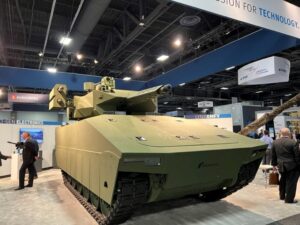American Rheinmetall Vehicles is offering a hybrid-electric design with its Lynx concept for the Army’s Optionally Manned Fighting Vehicle (OMFV) competition, with the company citing the ability to provide increased power generation on the battlefield as a key capability for its offering.
“That’ll be the first of its kind in a combat vehicle for the U.S. Army. It’s capable of producing 200 kilowatts of power. So there’s more than enough power for this vehicle to grow over the years,” Mike Milner, American Rheinmetall Vehicles’ director of business development and strategy, told Defense Daily
on Wednesday in an interview at the Association of the United States Army’s (AUSA) annual conference in Washington, D.C.

Rheinmetall is one of five firms working on refining concepts for the Army’s OMFV program to find a Bradley replacement, along with General Dynamics Land Systems [GD], Oshkosh Defense [OSK], BAE Systems and armor supplier Point Blank Enterprises.
Bids are due soon for OMFV’s detailed design and prototype build phases, with the Army planning to award up to three contracts for the work (Defense Daily, July 1).
Rheinmetall brought a full-scale mock-up of its Lynx concept for OMFV to the AUSA conference, with Milner citing Allison Transmission as a key partner providing the hybrid transmission to power the platform’s drivetrain.
“[Allison Transmission] came to us with the proposal for this hybrid transmission that will give us the ability to have the power. It’s a parallel hybrid system, so the engine’s the primary power source and we have a backup with the battery to provide some additional torque to the final drives, when needed, or to engage with silent watch,” Milner said.
Army officials have detailed a growing interest in exploring hybrid-electric technology for its vehicle fleets as an opportunity to reduce fuel consumption and logistics burdens, while also allowing for opportunities to get after improved capabilities such as capacity for increased exportable power.
“[Hybrid-electric] does provide that silent mobility and provides, what I think the Army really likes about it, is the large amount of power it generates,” Milner said.“So when you’re generating 220 kilowatts of power, you have that ability to put a 50-kilowatt laser on. Or you could put a 15-kilowatt laser on it with a 50mm cannon and be able to do counter-UAS and engage other items like that with the laser.”
Milner said Rheinmetall’s “large investment” into OMFV includes working on an automotive test rig to continue refining the hybrid transmission while the program continues through the digital design phase.
BAE Systems told Defense Daily on Tuesday it’s planning to build all future combat vehicles with capability for hybrid-electric power (Defense Daily, Oct. 11).